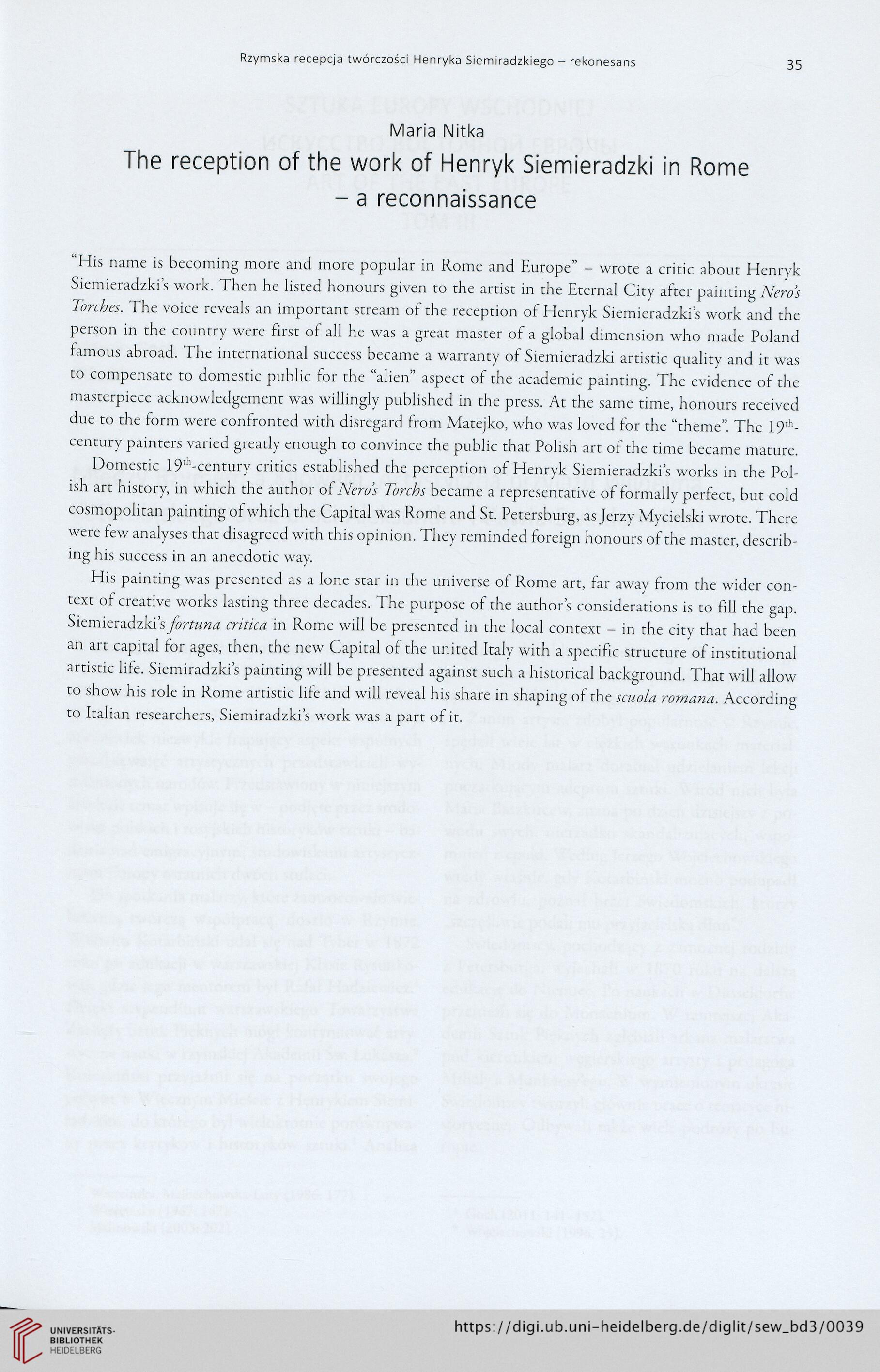Rzymska recepcja twórczości Henryka Siemiradzkiego - rekonesans
35
Maria Nitka
The reception of the work of Henryk Siemieradzki in Romę
- a reconnaissance
“His name is becoming morę and morę popular in Romę and Europę” - wrote a critic about Henryk
Siemieradzkis work. Then he listed honours given to the artist in the Eternal City after paintingNero’s
Torches. The voice reveals an important stream of the reception of Henryk Siemieradzki s work and the
person in the country were first of all he was a great master of a global dimension who madę Poland
famous abroad. The International success became a warranty of Siemieradzki artistic quality and it was
to compensate to domestic public for the “alien” aspect of the academic painting. The evidence of the
masterpiece acknowledgement was willingly published in the press. At the same time, honours received
due to the form were confronted with disregard from Matejko, who was loved for the “theme”. The 19th-
century painters varied greatly enough to convince the public that Polish art of the time became maturę.
Domestic 19lh-century critics established the perception of Henryk Siemieradzkis works in the Pol-
ish art history, in which the author of Nero’s Torchs became a representative of formally perfect, but cold
cosmopolitan painting of which the Capital was Romę and St. Petersburg, as Jerzy Mycielski wrote. There
were few analyses that disagreed with this opinion. They reminded foreign honours of the master, describ-
ing his success in an anecdotic way.
His painting was presented as a lone star in the universe of Romę art, far away from the wider con-
text of Creative works lasting three decades. The purpose of the author s considerations is to fili the gap.
Siemieradzkisfortuna critica in Romę will be presented in the local context - in the city that had been
an art Capital for ages, then, the new Capital of the united Italy with a specific structure of institutional
artistic life. Siemiradzkis painting will be presented against such a historical background. That will allow
to show his role in Romę artistic life and will reveal his share in shaping of the scuola romana. According
to Italian researchers, Siemiradzkis work was a part of it.
35
Maria Nitka
The reception of the work of Henryk Siemieradzki in Romę
- a reconnaissance
“His name is becoming morę and morę popular in Romę and Europę” - wrote a critic about Henryk
Siemieradzkis work. Then he listed honours given to the artist in the Eternal City after paintingNero’s
Torches. The voice reveals an important stream of the reception of Henryk Siemieradzki s work and the
person in the country were first of all he was a great master of a global dimension who madę Poland
famous abroad. The International success became a warranty of Siemieradzki artistic quality and it was
to compensate to domestic public for the “alien” aspect of the academic painting. The evidence of the
masterpiece acknowledgement was willingly published in the press. At the same time, honours received
due to the form were confronted with disregard from Matejko, who was loved for the “theme”. The 19th-
century painters varied greatly enough to convince the public that Polish art of the time became maturę.
Domestic 19lh-century critics established the perception of Henryk Siemieradzkis works in the Pol-
ish art history, in which the author of Nero’s Torchs became a representative of formally perfect, but cold
cosmopolitan painting of which the Capital was Romę and St. Petersburg, as Jerzy Mycielski wrote. There
were few analyses that disagreed with this opinion. They reminded foreign honours of the master, describ-
ing his success in an anecdotic way.
His painting was presented as a lone star in the universe of Romę art, far away from the wider con-
text of Creative works lasting three decades. The purpose of the author s considerations is to fili the gap.
Siemieradzkisfortuna critica in Romę will be presented in the local context - in the city that had been
an art Capital for ages, then, the new Capital of the united Italy with a specific structure of institutional
artistic life. Siemiradzkis painting will be presented against such a historical background. That will allow
to show his role in Romę artistic life and will reveal his share in shaping of the scuola romana. According
to Italian researchers, Siemiradzkis work was a part of it.




